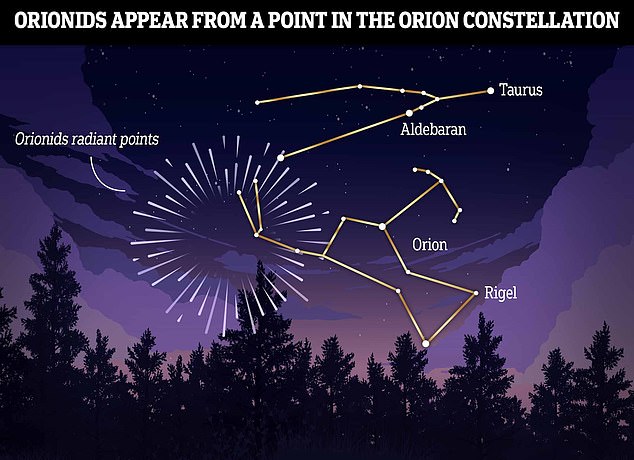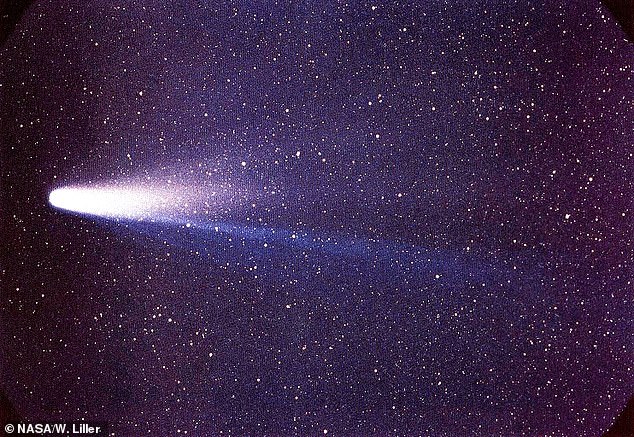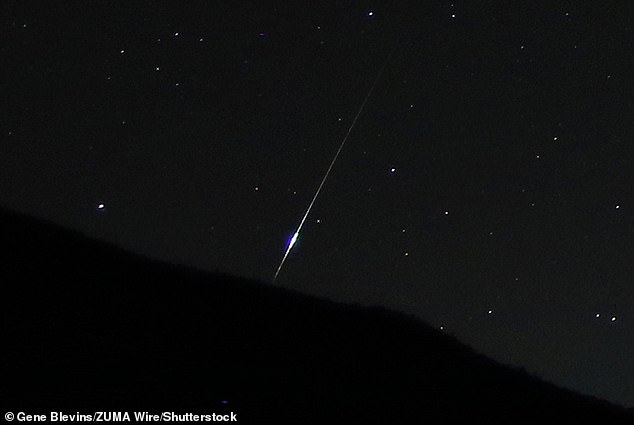The Orionid Meteor Shower will peak tonight with up to 25 shooting stars per hour – here’s how you can watch the spectacular display from where you live
Stargazing fans are in for a treat tonight as the year’s ‘most reliable’ meteor shower reaches its peak.
Eagle-eyed skygazers will be able to see the spectacular Orionid Meteor Shower at its most active.
Every October, Earth passes over the debris of Halley’s Comet, causing a burst of meteors to emerge from the constellation Orion.
Tonight, as our planet moves through the densest part of the debris field, as many as 25 fast-moving shooting stars will illuminate the sky every hour.
The best time to watch the shower is between midnight and the early hours of tomorrow morning, but meteors can be spotted anytime after dark.
To make things even better, experts say you don’t need any special equipment to see the brilliant Orionids wherever you are.
And with clear skies forecast over England, Wales and parts of Scotland, conditions could be just right to get a great view of the annual spectacle.
Stargazers will be in for a treat tonight as the spectacular Orionid Meteor Shower reaches peak activity from midnight. Pictured: The Orionid meteor shower over Clun Castle, Shropshire
Jessica Lee, astronomer at the Royal Observatory Greenwich, told MailOnline: ‘A meteor shower is made up of tiny bits of cometary debris that enter our atmosphere at such incredible speeds that they heat up and glow brightly.
“We have meteor showers at regular intervals throughout the year as the Earth moves through clouds of this material as it moves around the sun.”
As Comet 1P/Halley, better known as Halley’s Comet, completes its 75-year cycle around the Sun, it leaves behind a trail of dust and ice particles.
When the Earth passes through this cloud, these tiny particles, some of which are no larger than a grain of sand, enter our atmosphere at a speed of 40 miles per second.
Because the debris cloud is so large, the Orionids are active for almost a month.
Ms Lee said: ‘There will be meteors visible from this shower from October 2 to November 7, but the peak will be on the night of October 21-22.
‘The later you can stay up, the more meteors you can see. After midnight is better, but you can catch one at any time of the night as long as it’s dark.’
Shooting stars can be faint even at their brightest, so for the best views, try to find a dark spot with a good unobstructed view of the sky.

To find the Orionids, look east after midnight and try to find the constellation Orion. The meteors appear to be coming from the region around Orion’s ‘club’, so keep an eye on this region
Also make sure you give your eyes enough time to adjust to the darkness by turning off your flashlights and putting your phone away for at least 10 minutes.
You should also be prepared to wait a while, so bring plenty of warm clothes and a comfortable chair if possible.
Since annual meteor showers always appear in the same part of the sky, this should make it easy to find the meteor shower.
Ms Lee says: ‘They are called the Orionids because they appear to come from the constellation Orion, which will be in the east after midnight.’
To make sure you’re looking in the right direction, just look for the three prominent stars that make up Orion’s belt.
However, the meteors don’t always emerge from Orion itself, so be sure to look around the edges of the constellation and especially around the stars known as Orion’s club.
Fortunately, following the arrival of Storm Ashley this weekend, Britain may finally have clear skies on the horizon.
Although conditions will be cloudy for most of the day, they will start to clear from midnight.

The Orionids occur every year as Earth passes through the wave of debris left behind by Halley’s Comet (pictured) as it completes its 75-year orbit around the Sun
According to the Met Office forecast, most of England and Wales will see largely cloudless skies at 2am before cloud returns in the morning.
Scottish stargazers won’t be so lucky, but there are still plenty of gaps in the clouds predicted over most of the region.
A Met Office spokesperson told MailOnline: ‘This evening the rain will clear in the south east leaving clear spells elsewhere, with further showers in the north and west overnight.
‘Scattered fog will develop over central and south-eastern parts of England tonight.’
The biggest problem with stargazing tonight will be that the moon is still waning and will be about 80 percent full.
Unfortunately, the moon’s bright light makes it more difficult to see some of the fainter shooting stars.
But if you miss this evening, don’t worry.
Although the official peak of the Orionid Meteor Shower is on October 21 and 22, the shower has a very broad peak.

When Halley’s Comet dust grains hit Earth, they produced extremely fast-moving shooting stars with fine trails. The shower will be at its peak in the next two to three days and will continue until November 7. Pictured: A meter of the Orionid Meteor Shower, imaged by NASA
That means meteor activity will likely remain at its highest for about three days after tonight.
Even then, the shower will be active until November 7, so there are plenty of chances to see this annual display if you can’t make it this week.
And if you miss the Orionids altogether, there are four more meteor showers coming before the end of the year.
Next month, budding astronomers can watch the Tuarid and Leonid Meteor Rains.
Meanwhile, December will also see two meteor showers, including the Geminids – the most spectacular shower of the year, with up to 150 shooting stars per hour.
